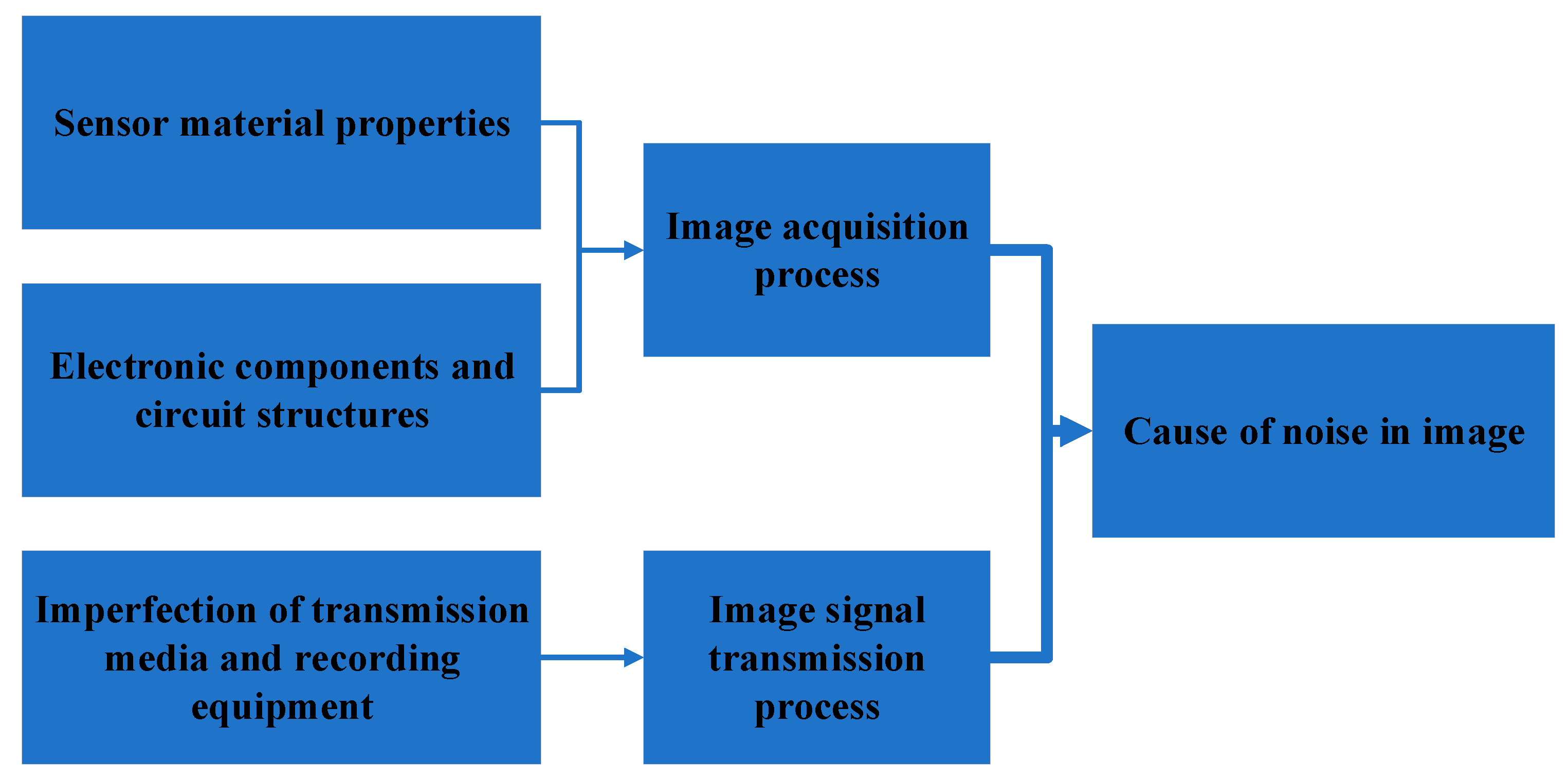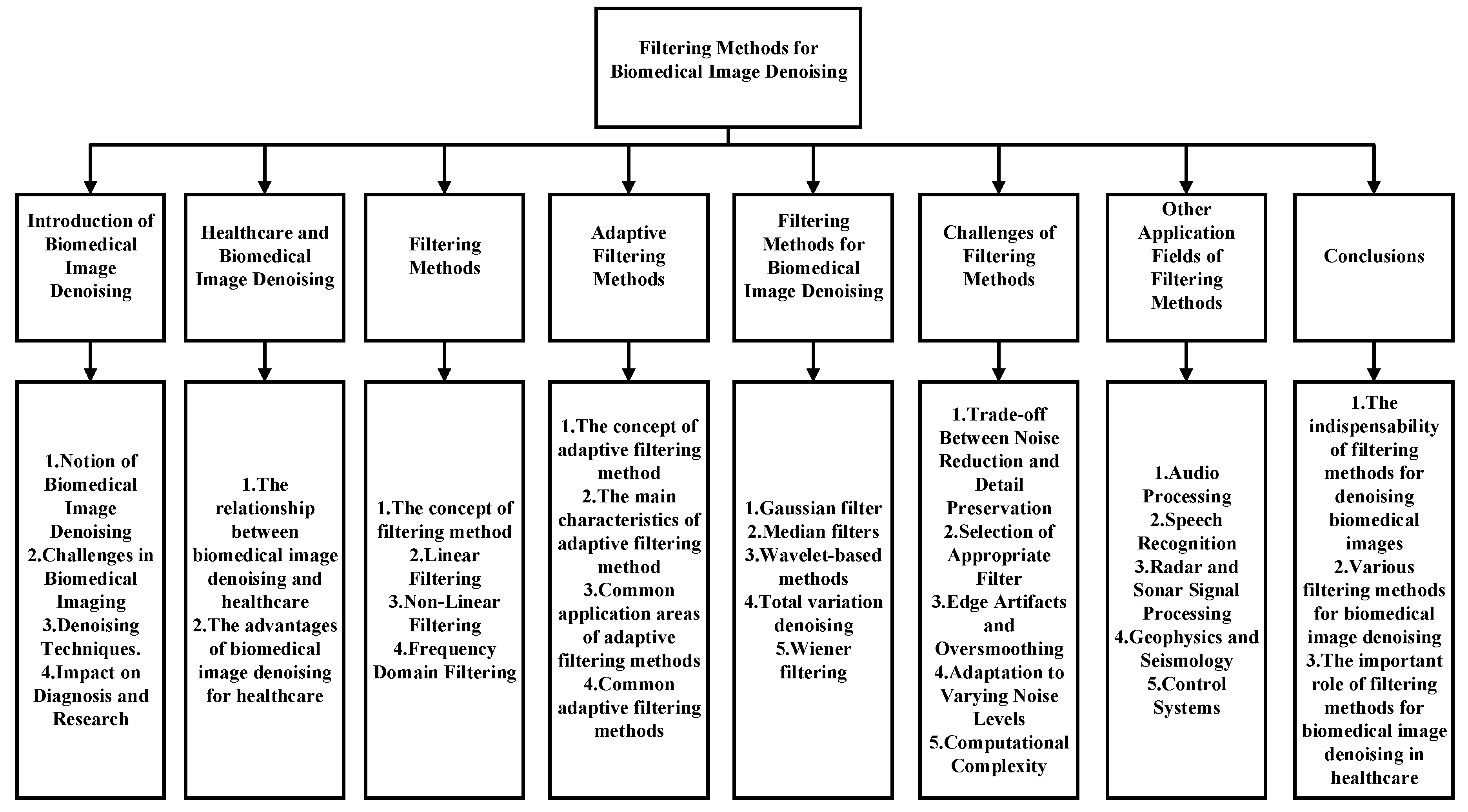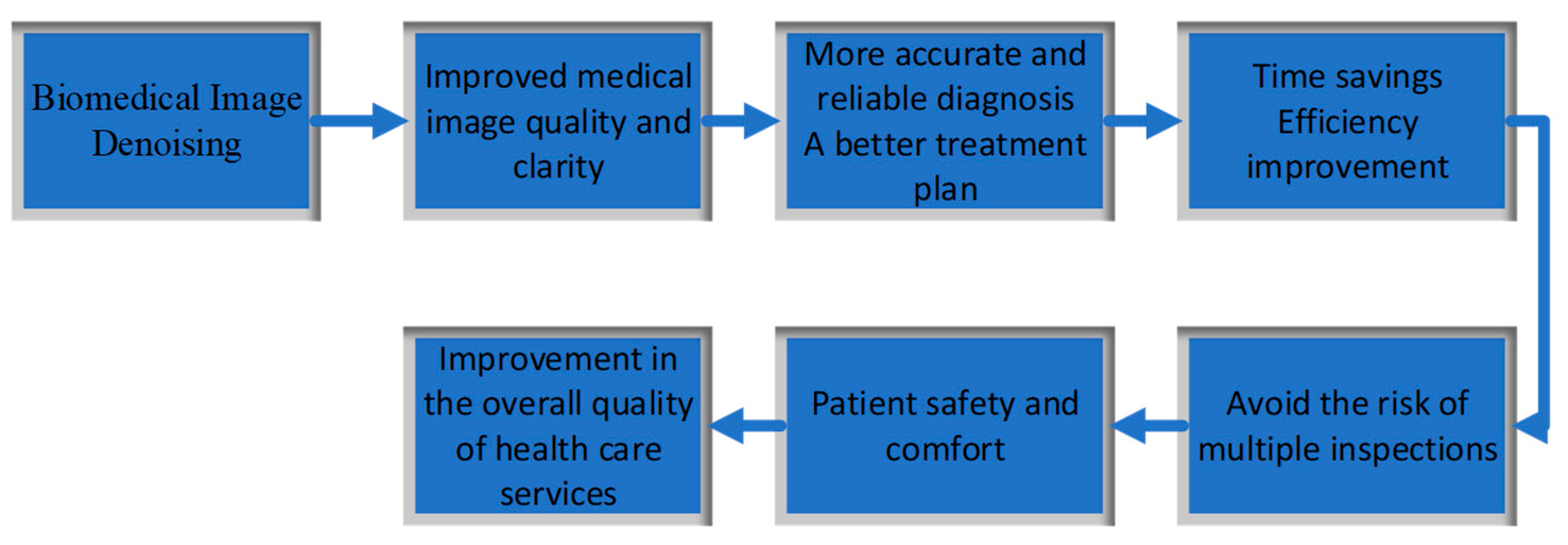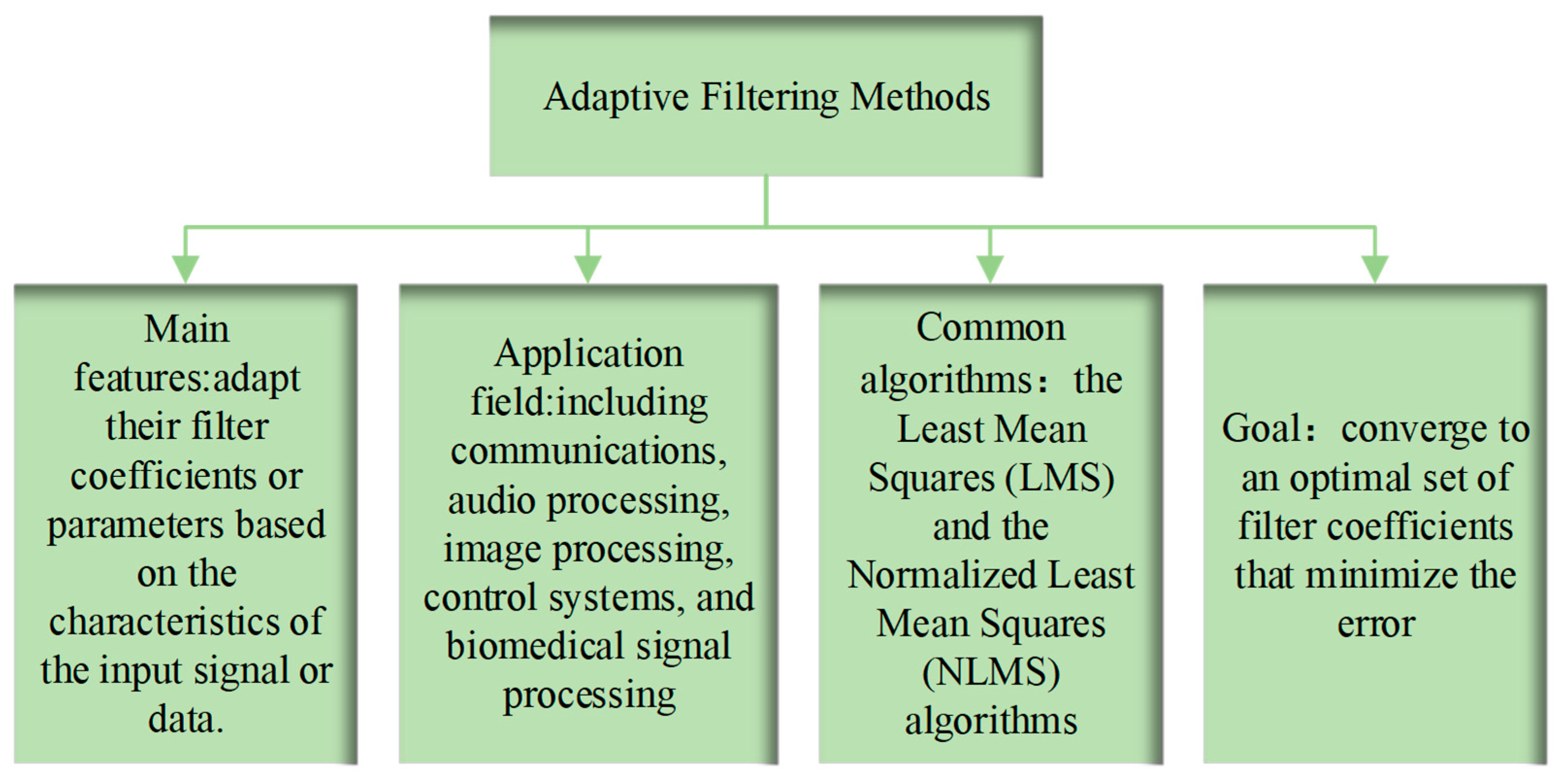Submitted:
18 October 2023
Posted:
18 October 2023
You are already at the latest version
Abstract
Keywords:
1. Introduction of Biomedical Image Denoising
2. Healthcare and Biomedical Image Denoising
3. Filtering Methods
4. Adaptive Filtering Methods
5. Filtering Methods for Biomedical Image Denoising
6. Challenges of Filtering Methods
7. Other Application Fields of Filtering Methods
8. Conclusions
Funding
Acknowledgments
References
- S. Wang, "Detection of Dendritic Spines using Wavelet Packet Entropy and Fuzzy Support Vector Machine," CNS & Neurological Disorders - Drug Targets, vol. 16, pp. 116-121, 2017. [CrossRef]
- Y.-D. Zhang, "Advanced deep learning methods for biomedical information analysis: An editorial," Neural networks, vol. 133, pp. 101-102, 2021. [CrossRef]
- S. Wang, "Advances in data preprocessing for biomedical data fusion: an overview of the methods, challenges, and prospects," Information Fusion, vol. 76, pp. 376-421, 2021.
- C. P. Loizou and C. S. Pattichis, Despeckle filtering for ultrasound imaging and video, volume I: Algorithms and software: Springer Nature, 2022.
- Y. Zhang, "A Fast Document Image Denoising Method based on Packed Binary format and Source Word Accumulation," Journal of Convergence Information Technology, vol. 6, pp. 131-137, 2011.
- C. Huang, "Analysis methods of coronary artery intravascular images: A review," Neurocomputing, vol. 489, pp. 27-39, 2022. [CrossRef]
- S. V. M. Sagheer and S. N. George, "A review on medical image denoising algorithms," Biomedical signal processing and control, vol. 61, p. 102036, 2020. [CrossRef]
- S.-H. Wang and S. Fernandes, "AVNC: Attention-based VGG-style network for COVID-19 diagnosis by CBAM," IEEE Sensors Journal, vol. 22, pp. 17431 - 17438, 2022. [CrossRef]
- F. Garcea, A. Serra, F. Lamberti, and L. Morra, "Data augmentation for medical imaging: A systematic literature review," Computers in Biology and Medicine, p. 106391, 2022. [CrossRef]
- Z. Chen, K. Pawar, M. Ekanayake, C. Pain, S. Zhong, and G. F. Egan, "Deep learning for image enhancement and correction in magnetic resonance imaging—state-of-the-art and challenges," Journal of Digital Imaging, vol. 36, pp. 204-230, 2023. [CrossRef]
- K. B. Johnson, W. Q. Wei, D. Weeraratne, M. E. Frisse, K. Misulis, K. Rhee, et al., "Precision medicine, AI, and the future of personalized health care," Clinical and translational science, vol. 14, pp. 86-93, 2021. [CrossRef]
- J. Huang, Z. Zhao, C. Ren, Q. Teng, and X. He, "A prior-guided deep network for real image denoising and its applications," Knowledge-Based Systems, vol. 255, p. 109776, 2022. [CrossRef]
- S. Wang, "Magnetic resonance brain classification by a novel binary particle swarm optimization with mutation and time-varying acceleration coefficients," Biomedical Engineering-Biomedizinische Technik, vol. 61, pp. 431-441, 2016. [CrossRef]
- G. V. Sai, C. Seshank, P. P. S. Krishna, and J. S. Dhatterwal, "Reduction of Noise in Medical Imaging Quality," in 2023 International Conference on Disruptive Technologies (ICDT), 2023, pp. 364-368.
- A. Albahri, A. M. Duhaim, M. A. Fadhel, A. Alnoor, N. S. Baqer, L. Alzubaidi, et al., "A systematic review of trustworthy and explainable artificial intelligence in healthcare: Assessment of quality, bias risk, and data fusion," Information Fusion, 2023.
- F. A. Al-Joufi, A. Setia, M. M. Salem-Bekhit, R. K. Sahu, F. Y. Alqahtani, R. Widyowati, et al., "Molecular pathogenesis of colorectal cancer with an emphasis on recent advances in biomarkers, as well as nanotechnology-based diagnostic and therapeutic approaches," Nanomaterials, vol. 12, p. 169, 2022.
- A. Tariq, A. Y. Gill, and H. K. Hussain, "Evaluating the Potential of Artificial Intelligence in Orthopedic Surgery for Value-based Healthcare," International Journal of Multidisciplinary Sciences and Arts, vol. 2, pp. 27-35, 2023. [CrossRef]
- L. R. Koetzier, D. Mastrodicasa, T. P. Szczykutowicz, N. R. van der Werf, A. S. Wang, V. Sandfort, et al., "Deep learning image reconstruction for CT: technical principles and clinical prospects," Radiology, vol. 306, p. e221257, 2023. [CrossRef]
- arXiv:2309.11820.A. Ramesh, A. Nandanan, P. N. MD, and G. Gressel, "Automatic Endoscopic Ultrasound Station Recognition with Limited Data," arXiv preprint arXiv:2309.11820, 2023.
- M. Strunga, R. Urban, J. Surovková, and A. Thurzo, "Artificial intelligence systems assisting in the assessment of the course and retention of orthodontic treatment," in Healthcare, 2023, p. 683. [CrossRef]
- A. Saeed, "Improved Diagnosis of COVID-19 with CXGNet: A Deep CNN with Enhanced Grey-wolf Optimizer," 2023.
- D. C. Prakash, R. Narayanan, N. Ganesh, M. Ramachandran, S. Chinnasami, and R. Rajeshwari, "A study on image processing with data analysis," in AIP Conference Proceedings, 2022.
- D. Sen, B. B. Mishra, and P. K. Pattnaik, "A Review of the Filtering Techniques used in EEG Signal Processing," in 2023 7th International Conference on Trends in Electronics and Informatics (ICOEI), 2023, pp. 270-277.
- T. Yang, H. Yu, and Y. Wang, "An efficient low-pass-filtering algorithm to de-noise global GRACE data," Remote Sensing of Environment, vol. 283, p. 113303, 2022. [CrossRef]
- C. Tang, X. Wang, Y. Bai, Z. Wu, J. Zhang, and Y. Huang, "Learning spatial-frequency transformer for visual object tracking," IEEE Transactions on Circuits and Systems for Video Technology, 2023. [CrossRef]
- X. Lv, R. T. Ako, M. Bhaskaran, S. Sriram, C. Fumeaux, and W. Withayachumnankul, "Frequency-selective-surface-based mechanically reconfigurable terahertz bandpass filter," IEEE Transactions on Terahertz Science and Technology, vol. 12, pp. 257-266, 2022. [CrossRef]
- S. Kocoń and J. Piskorowski, "Power Line Interference Removal From Short-Latency Evoked Potentials Using Digital Time-Efficient Selective Elliptic Notch Filter," IEEE Transactions on Instrumentation and Measurement, vol. 71, pp. 1-9, 2022. [CrossRef]
- arXiv:2204.09302.S. Satpathy, S. Panda, K. K. Nagwanshi, S. Nayak, and C. Ardil, "Adaptive non-linear filtering technique for image restoration," arXiv preprint arXiv:2204.09302, 2022.
- C. S. K. Abdulah, M. N. K. H. Rohani, B. Ismail, M. A. M. Isa, A. S. Rosmi, W. A. W. Mustafa, et al., "Review Study of Image De-Noising on Digital Image Processing and Applications," Journal of Advanced Research in Applied Sciences and Engineering Technology, vol. 30, pp. 331-343, 2023. [CrossRef]
- S. Gantenapalli, P. Choppala, V. Gullipalli, J. Meka, and P. Teal, "A fast method for impulse noise reduction in digital color images using anomaly median filtering," in 2022 IEEE 5th International Conference on Image Processing Applications and Systems (IPAS), 2022, pp. 1-6.
- F. Zhang, Y. Wu, M. Xu, S. Liu, C. Peng, and Z. Gao, "A Morphological Image Segmentation Algorithm for Circular Overlapping Cells," Intelligent Automation & Soft Computing, vol. 32, 2022. [CrossRef]
- J. A. Stuchi, N. G. Canto, L. Boccato, and R. Attux, "A frequency-domain approach with learnable filters for image classification," Available at SSRN 4333420, 2023.
- H. Shuai, L. Junxia, W. Lei, and Z. Wei, "Research on acoustic fault diagnosis of bearings based on spatial filtering and time-frequency domain filtering," Measurement, p. 113533, 2023. [CrossRef]
- R. Al Sobbahi and J. Tekli, "Low-light homomorphic filtering network for integrating image enhancement and classification," Signal Processing: Image Communication, vol. 100, p. 116527, 2022. [CrossRef]
- Y. Ding, Z. Zhang, X. Zhao, D. Hong, W. Li, W. Cai, et al., "AF2GNN: Graph convolution with adaptive filters and aggregator fusion for hyperspectral image classification," Information Sciences, vol. 602, pp. 201-219, 2022.
- Z. Chi, J. Jiang, X. Diao, Q. Chen, L. Ni, Z. Wang, et al., "Novel leakage detection method by improved adaptive filtering and pattern recognition based on acoustic waves," International Journal of Pattern Recognition and Artificial Intelligence, vol. 36, p. 2259001, 2022. [CrossRef]
- X. Yan and M. Jia, "Bearing fault diagnosis via a parameter-optimized feature mode decomposition," Measurement, vol. 203, p. 112016, 2022.
- R. Rajalakshmi, G. Vishnupriya, R. Sudharsanan, S. Navaneethan, P. Vijayakumari, and M. Karthikeyan, "Digital Filter Design on High speed Communication with Low Power Criteria," in 2023 International Conference on Computer Communication and Informatics (ICCCI), 2023, pp. 1-5.
- arXiv:2209.11899.D. Alpay, K. Diki, and M. Vajiac, "Two bicomplex least mean square (BLMS) algorithms," arXiv preprint arXiv:2209.11899, 2022.
- A.-G. Rusu, C. Paleologu, J. Benesty, and S. Ciochină, "A variable step size normalized least-mean-square algorithm based on data reuse," Algorithms, vol. 15, p. 111, 2022. [CrossRef]
- J. Casebeer, N. J. Bryan, and P. Smaragdis, "Meta-af: Meta-learning for adaptive filters," IEEE/ACM Transactions on Audio, Speech, and Language Processing, vol. 31, pp. 355-370, 2022. [CrossRef]
- H. Javaid, "Adaptive Filter Utilizing Recursive Least Squares Algorithm with Adaptive Forgetting Factor," Texas A&M University-Kingsville, 2023.
- K. N. Watcharasupat, T. N. T. Nguyen, W.-S. Gan, S. Zhao, and B. Ma, "End-to-end complex-valued multidilated convolutional neural network for joint acoustic echo cancellation and noise suppression," in ICASSP 2022-2022 IEEE International Conference on Acoustics, Speech and Signal Processing (ICASSP), 2022, pp. 656-660.
- Y. Zhang, "Smart detection on abnormal breasts in digital mammography based on contrast-limited adaptive histogram equalization and chaotic adaptive real-coded biogeography-based optimization," Simulation, vol. 92, pp. 873-885, 2016. [CrossRef]
- M. Ivanov, M. Posysoev, and A. P. Lyubartsev, "Coarse-Grained Modeling Using Neural Networks Trained on Structural Data," Journal of Chemical Theory and Computation, vol. 19, pp. 6704-6717, 2023. [CrossRef]
- R. Vankdothu and M. A. Hameed, "Brain tumor MRI images identification and classification based on the recurrent convolutional neural network," Measurement: Sensors, vol. 24, p. 100412, 2022. [CrossRef]
- Y. D. Zhang and S. Satapathy, "A seven-layer convolutional neural network for chest CT-based COVID-19 diagnosis using stochastic pooling," IEEE Sensors Journal, vol. 22, pp. 17573 - 17582, 2022.
- A. Kaur and G. Dong, "A Complete Review on Image Denoising Techniques for Medical Images," Neural Processing Letters, pp. 1-44, 2023. [CrossRef]
- A. Azarkaman, P. R. Deilamani, and N. Ghorbani, Medical Devices Engineering Textbook 1: Nobel TM, 2022.
- X. Zhang and C. He, "Robust double-weighted guided image filtering," Signal Processing, vol. 199, p. 108609, 2022.
- G. Ramesh, J. Logeshwaran, J. Gowri, and A. Mathew, "The management and reduction of digital noise in video image processing by using transmission based noise elimination scheme," ICTACT Journal on Image & Video Processing, vol. 13, 2022.
- A. Halidou, Y. Mohamadou, A. A. A. Ari, and E. J. G. Zacko, "Review of wavelet denoising algorithms," Multimedia Tools and Applications, pp. 1-31, 2023. [CrossRef]
- M. Diwakar, P. Kumar, P. Singh, A. Tripathi, and L. Singh, "An efficient reversible data hiding using SVD over a novel weighted iterative anisotropic total variation based denoised medical images," Biomedical Signal Processing and Control, vol. 82, p. 104563, 2023. [CrossRef]
- Y. Shi and A. Singer, "Ab-initio contrast estimation and denoising of cryo-EM images," Computer Methods and Programs in Biomedicine, vol. 224, p. 107018, 2022. [CrossRef]
- G. Liu, M. Dang, J. Liu, R. Xiang, Y. Tian, and N. Luo, "True wide convolutional neural network for image denoising," Information Sciences, vol. 610, pp. 171-184, 2022. [CrossRef]
- X. Liu, M. Pedersen, and R. Wang, "Survey of natural image enhancement techniques: Classification, evaluation, challenges, and perspectives," Digital Signal Processing, vol. 127, p. 103547, 2022.
- S. Kumar and Y. Kurmi, "CNN-based denoising system for the image quality enhancement," Multimedia Tools and Applications, vol. 81, pp. 20147-20174, 2022. [CrossRef]
- D. C. Lepcha, B. Goyal, A. Dogra, and V. Goyal, "Image super-resolution: A comprehensive review, recent trends, challenges and applications," Information Fusion, 2022.
- Y. Bi, B. Xue, P. Mesejo, S. Cagnoni, and M. Zhang, "A survey on evolutionary computation for computer vision and image analysis: Past, present, and future trends," IEEE Transactions on Evolutionary Computation, vol. 27, pp. 5-25, 2022.
- S. Chhetri, M. S. Joshi, C. V. Mahamuni, R. N. Sangeetha, and T. Roy, "Speech Enhancement: A Survey of Approaches and Applications," in 2023 2nd International Conference on Edge Computing and Applications (ICECAA), 2023, pp. 848-856.
- M. Labied, A. Belangour, M. Banane, and A. Erraissi, "An overview of Automatic Speech Recognition Preprocessing Techniques," in 2022 International Conference on Decision Aid Sciences and Applications (DASA), 2022, pp. 804-809.
- Y. Lin, L. Zhang, H. Han, Y. Li, W. Shen, and Y. Wang, "Periodic-Filtering Method for Low-SNR Vibration Radar Signal," Remote Sensing, vol. 15, p. 3461, 2023. [CrossRef]
- M. S. Abdalzaher, H. A. Elsayed, and M. M. Fouda, "Employing remote sensing, data communication networks, ai, and optimization methodologies in seismology," IEEE Journal of Selected Topics in Applied Earth Observations and Remote Sensing, vol. 15, pp. 9417-9438, 2022.
- X. Shen, D. Shi, W.-S. Gan, and S. Peksi, "Adaptive-gain algorithm on the fixed filters applied for active noise control headphone," Mechanical Systems and Signal Processing, vol. 169, p. 108641, 2022. [CrossRef]
- P. Datta and R. Rohilla, "Denoising Magnetic Resonance Images with Rician Noise Based On Deep Learning," in 2022 International Conference on Computational Intelligence and Sustainable Engineering Solutions (CISES), 2022, pp. 545-550.
- Z. Haider, "Deep Learning-based Image Denoising Techniques: A Survey and Comparative Study," 2023.
- K. S. H. Kulathilake, N. A. Abdullah, A. Q. M. Sabri, A. R. Bandara, and K. W. Lai, "A review on self-adaptation approaches and techniques in medical image denoising algorithms," Multimedia Tools and Applications, vol. 81, pp. 37591-37626, 2022. [CrossRef]






| Linear Filtering | Frequency | Function | |
|---|---|---|---|
| Low-pass filters | Allow low-frequency components to pass through while attenuating high-frequency components | Making them useful for smoothing or noise reduction | |
| High-pass filters | Emphasize high-frequency components while suppressing low-frequency ones | Often used for edge detection | |
| Bandpass filters | Allow a specific range of frequencies | Ideal for isolating a particular frequency band of interest | |
| Notch filters | Reject a specific frequency or narrow frequency range | Remove unwanted interference or noise at specific frequencies |
| Filtering methods | Relationship with filtering results | Implementation method | Common filter | Function implementation |
|---|---|---|---|---|
| Linear Filtering | Arithmetic operation | Add, subtract, multiply, divide and so on | Gaussian filter,Mean filter | Definite and unique transfer function |
| Non-Linear Filtering | Logical relation | Logical operation | Maximum filter,Minimum filter,Median filter | Unspecified transfer function |
| Filtering methods | Data processing | Function | |
|---|---|---|---|
| Gaussian filters | Apply a weighted average to pixel values within a local neighborhood | Reducing Gaussian noise, which is characterized by a bell-shaped probability distribution. | |
| Median filters | Replace each pixel with the median value within a local window | Removing impulse noise | |
| Wavelet-based methods | Decompose an image into different frequency components | Well-suited for medical images with varying textures and structures | |
| Total variation denoising | Regularization technique, minimizes the total variation in pixel values within the image | Smoothing the image while maintaining sharp boundaries | |
| Wiener filtering | Minimizes the mean squared error between the estimated image and the true image | Useful when noise statistics are known or can be estimated accurately |
Disclaimer/Publisher’s Note: The statements, opinions and data contained in all publications are solely those of the individual author(s) and contributor(s) and not of MDPI and/or the editor(s). MDPI and/or the editor(s) disclaim responsibility for any injury to people or property resulting from any ideas, methods, instructions or products referred to in the content. |
© 2023 by the authors. Licensee MDPI, Basel, Switzerland. This article is an open access article distributed under the terms and conditions of the Creative Commons Attribution (CC BY) license (http://creativecommons.org/licenses/by/4.0/).




